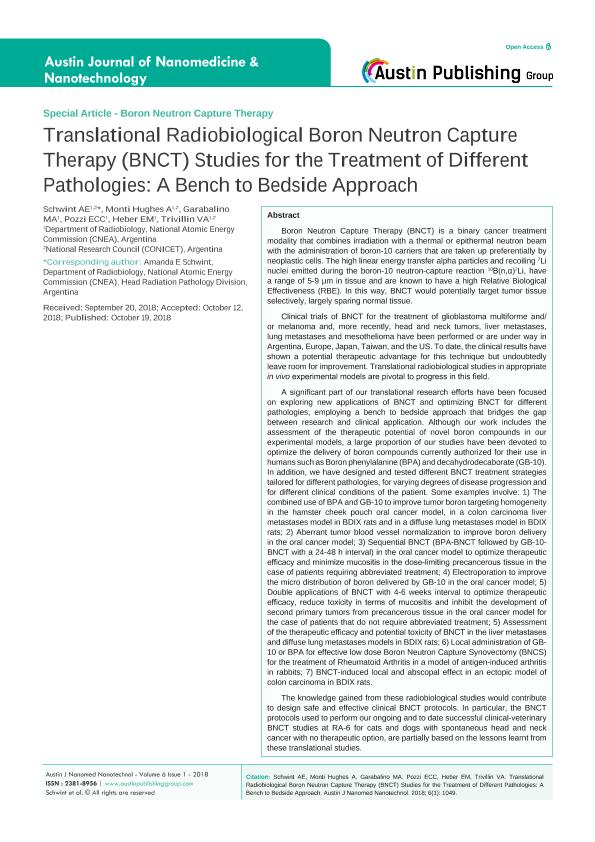Mostrar el registro sencillo del ítem
dc.contributor.author
Schwint, Amanda Elena

dc.contributor.author
Monti Hughes, Andrea

dc.contributor.author
Garabalino, Marcela Alejandra

dc.contributor.author
Pozzi, Emiliano César Cayetano

dc.contributor.author
Heber, Elisa Mercedes

dc.contributor.author
Trivillin, Verónica Andrea

dc.date.available
2022-11-25T16:53:55Z
dc.date.issued
2018-09
dc.identifier.citation
Schwint, Amanda Elena; Monti Hughes, Andrea; Garabalino, Marcela Alejandra; Pozzi, Emiliano César Cayetano; Heber, Elisa Mercedes; et al.; Translational Radiobiological Boron Neutron Capture Therapy (BNCT) Studies for the Treatment of Different Pathologies: A Bench to Bedside Approach; Austin Publications LLC; Austin journal of nanomedicine & nanotechnology; 6; 1; 9-2018; 1-12
dc.identifier.issn
2381-8956
dc.identifier.uri
http://hdl.handle.net/11336/179059
dc.description.abstract
Boron Neutron Capture Therapy (BNCT) is a binary cancer treatment modality that combines irradiation with a thermal or epithermal neutron beam with the administration of boron-10 carriers that are taken up preferentially by neoplastic cells. The high linear energy transfer alpha particles and recoiling 7 Li nuclei emitted during the boron-10 neutron-capture reaction 10B(n,α)7 Li, have a range of 5-9 µm in tissue and are known to have a high Relative Biological Effectiveness (RBE). In this way, BNCT would potentially target tumor tissue selectively, largely sparing normal tissue. Clinical trials of BNCT for the treatment of glioblastoma multiforme and/ or melanoma and, more recently, head and neck tumors, liver metastases, lung metastases and mesothelioma have been performed or are under way in Argentina, Europe, Japan, Taiwan, and the US. To date, the clinical results have shown a potential therapeutic advantage for this technique but undoubtedly leave room for improvement. Translational radiobiological studies in appropriate in vivo experimental models are pivotal to progress in this field. A significant part of our translational research efforts have been focused on exploring new applications of BNCT and optimizing BNCT for different pathologies, employing a bench to bedside approach that bridges the gap between research and clinical application. Although our work includes the assessment of the therapeutic potential of novel boron compounds in our experimental models, a large proportion of our studies have been devoted to optimize the delivery of boron compounds currently authorized for their use in humans such as Boron phenylalanine (BPA) and decahydrodecaborate (GB-10). In addition, we have designed and tested different BNCT treatment strategies tailored for different pathologies, for varying degrees of disease progression and for different clinical conditions of the patient. Some examples involve: 1) The combined use of BPA and GB-10 to improve tumor boron targeting homogeneity in the hamster cheek pouch oral cancer model, in a colon carcinoma liver metastases model in BDIX rats and in a diffuse lung metastases model in BDIX rats; 2) Aberrant tumor blood vessel normalization to improve boron delivery in the oral cancer model; 3) Sequential BNCT (BPA-BNCT followed by GB-10- BNCT with a 24-48 h interval) in the oral cancer model to optimize therapeutic efficacy and minimize mucositis in the dose-limiting precancerous tissue in the case of patients requiring abbreviated treatment; 4) Electroporation to improve the micro distribution of boron delivered by GB-10 in the oral cancer model; 5) Double applications of BNCT with 4-6 weeks interval to optimize therapeutic efficacy, reduce toxicity in terms of mucositis and inhibit the development of second primary tumors from precancerous tissue in the oral cancer model for the case of patients that do not require abbreviated treatment; 5) Assessment of the therapeutic efficacy and potential toxicity of BNCT in the liver metastases and diffuse lung metastases models in BDIX rats; 6) Local administration of GB10 or BPA for effective low dose Boron Neutron Capture Synovectomy (BNCS) for the treatment of Rheumatoid Arthritis in a model of antigen-induced arthritis in rabbits; 7) BNCT-induced local and abscopal effect in an ectopic model of colon carcinoma in BDIX rats. The knowledge gained from these radiobiological studies would contribute to design safe and effective clinical BNCT protocols. In particular, the BNCT protocols used to perform our ongoing and to date successful clinical-veterinary BNCT studies at RA-6 for cats and dogs with spontaneous head and neck cancer with no therapeutic option, are partially based on the lessons learnt from these translational studies.
dc.format
application/pdf
dc.language.iso
eng
dc.publisher
Austin Publications LLC
dc.rights
info:eu-repo/semantics/openAccess
dc.rights.uri
https://creativecommons.org/licenses/by-nc-sa/2.5/ar/
dc.subject
BNCT
dc.subject
Translational studies
dc.subject.classification
Otras Medicina Básica

dc.subject.classification
Medicina Básica

dc.subject.classification
CIENCIAS MÉDICAS Y DE LA SALUD

dc.title
Translational Radiobiological Boron Neutron Capture Therapy (BNCT) Studies for the Treatment of Different Pathologies: A Bench to Bedside Approach
dc.type
info:eu-repo/semantics/article
dc.type
info:ar-repo/semantics/artículo
dc.type
info:eu-repo/semantics/publishedVersion
dc.date.updated
2022-11-10T15:24:20Z
dc.journal.volume
6
dc.journal.number
1
dc.journal.pagination
1-12
dc.journal.pais
Estados Unidos

dc.journal.ciudad
Texas
dc.description.fil
Fil: Schwint, Amanda Elena. Comisión Nacional de Energía Atómica. Gerencia de Area de Aplicaciones de la Tecnología Nuclear. Gerencia de Radiobiología (Centro Atómico Constituyentes); Argentina. Consejo Nacional de Investigaciones Científicas y Técnicas; Argentina
dc.description.fil
Fil: Monti Hughes, Andrea. Comisión Nacional de Energía Atómica. Gerencia de Area de Aplicaciones de la Tecnología Nuclear. Gerencia de Radiobiología (Centro Atómico Constituyentes); Argentina. Consejo Nacional de Investigaciones Científicas y Técnicas; Argentina
dc.description.fil
Fil: Garabalino, Marcela Alejandra. Comisión Nacional de Energía Atómica. Gerencia de Area de Aplicaciones de la Tecnología Nuclear. Gerencia de Radiobiología (Centro Atómico Constituyentes); Argentina
dc.description.fil
Fil: Pozzi, Emiliano César Cayetano. Comisión Nacional de Energía Atómica. Gerencia de Area de Aplicaciones de la Tecnología Nuclear. Gerencia de Radiobiología (Centro Atómico Constituyentes); Argentina
dc.description.fil
Fil: Heber, Elisa Mercedes. Comisión Nacional de Energía Atómica. Gerencia de Area de Aplicaciones de la Tecnología Nuclear. Gerencia de Radiobiología (Centro Atómico Constituyentes); Argentina
dc.description.fil
Fil: Trivillin, Verónica Andrea. Comisión Nacional de Energía Atómica. Gerencia de Area de Aplicaciones de la Tecnología Nuclear. Gerencia de Radiobiología (Centro Atómico Constituyentes); Argentina. Consejo Nacional de Investigaciones Científicas y Técnicas; Argentina
dc.journal.title
Austin journal of nanomedicine & nanotechnology
dc.relation.alternativeid
info:eu-repo/semantics/altIdentifier/url/https://austinpublishinggroup.com/nanomedicine-nanotechnology/v6-i1.php
dc.relation.alternativeid
info:eu-repo/semantics/altIdentifier/url/https://austinpublishinggroup.com/nanomedicine-nanotechnology/fulltext/ajnn-v6-id1049.pdf
Archivos asociados
